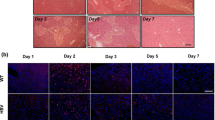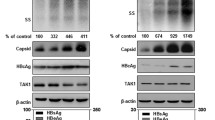Abstract
We have shown previously that insulin suppresses the expression of hepatitis B surface antigen (HBsAg) gene from an endogenous integrated viral genome in cultured human hepatoma Hep3B cells. In this study, we demonstrated that insulin suppresses the viral mRNA transcribed from transiently transfected tandem repeat hepatitis B virus (HBV) dimer DNA or DNA fragment that contains only the major HBsAg gene. Insulin treatment also resulted in a decrease in HBV viral particles produced by the HBV-DNA-transfected cells in a dose-dependent manner. Furthermore, when insulin was simultaneously added with glucocorticoid, which stimulates HBV gene expression, the stimulatory effect of glucocorticoid was completely abolished. Our results suggest that insulin has a dominant negative effect on the HBV gene expression in cultured human liver cells.
Similar content being viewed by others
References
Acs G, Sells MA, Purcell RH, Price P, Engle R, Shapiro M, Poper H. Hepatitis B virus produced by transfected HepG2 cells causes hepatitis in chimpanzees. Proc Natl Acad Sci USA 84:4641–4644;1987.
Cattaneo R, Will H, Darai G, Pfaff E, Schaller H. Detection of an element of the SV40 late promoter in vectors used for expression studies in COS cells. EMBO J 2:511–514;1983.
Chang C, Jeng KS, Hu CP, Lo SJ, Su TS, Ting LP, Chou KC, Han SH, Pfaff E, Salfeld J, Schaller H. Production of hepatitis B virus in vitro by transient expression of clones HBV DNA in a hepatoma cell line. EMBO J 6:675–680;1987.
Chou CK. The role of receptor kinase in insulin action and the effects of insulin on human hepatoma cells. Clin Biochem 23:37–41;1990.
Chou CK, Su TS, Chang C, Hu CP, Huang MY, Suen CS, Chou NW, Ting LP. Insulin suppresses hepatitis B surface antigen expression in human hepatoma cell. J Biol Chem 264:15304–15308;1989.
Chou CK, Wang LH, Lin HM, Chi CW. Glucorticoid stimulates hepatitis B viral gene expression in cultured human hepatoma cells. Hepatology 16:13–18;1992.
Chu DTW, Granner DK. The effect of phorbol esters and diacylglycerol on expression of the phosphoenolpyruvate carboxykinase gene in rat hepatoma H41IE cells. J Biol Chem 261:16848–16853;1986.
Granner D, Andrenone T, Saski K, Beale E. Inhibition of transcription of the phosphoenolpyruvate carboxykinase gene by insulin. Nature 305:549–551;1983.
Gripon P, Diot C, Corlu A, Guguen-Guillouzo C. Regulation by dimethylsulfoxide, insulin and corticosteroids of hepatitis B virus replication in a transfected human hepatoma cell line. J Med Virol 28:193–199;1989.
Knowles BB, Howe CC, Aden DP. Human hepatocellular carcinoma cell lines secrete the major plasma proteins and hepatitis B surface antigen. Science 209:497–499;1980.
Lo SJ, Lee YHW, Chiou JS, Ting LP, Liu WT, Choo KB. Characterization of restriction endonuclease maps of hepatitis B viral DNAs. Biochem Biophys Res Commun 129:797–803;1985.
Lucas PC, O'Brien RM, Mitchell JA, Davis CM, Imai E. A retinoic acid response element is part of a pleiotropic domain in the phosphoenolpyruvate carboxykinase gene. Proc Natl Acad Sci USA 88:2184–2188;1991.
Maniatis T, Fritsch DF, Sambrook J. Molecular Cloning, a Laboratory Manual. Cold Spring Harbor, Cold Spring Harbor Laboratory, 1982.
Messina JL, Hamlin J, Larner J. Effects of insulin alone and the accumulation of a specific mRNA in rat hepatoma cells. J Biol Chem 260:16418–16423;1985.
O'Brien RM, Bonovich MT, Forest CD, Granner DK. Signal transduction convergence: Phorbol esters and insulin inhibit phosphoenolpyruvate carboxykinase gene transcription through the same 10-base-pair sequence. Proc Natl Acad Sci USA 88:6580–6584;1991.
O'Brien RM, Lucas PC, Forest CD, Magnuson MA, Granner DK. Identification of a sequence in the PEPCK gene that mediates a negative effect of insulin on transcription. Science 249:533–537;1990.
Ran TK, Orgad L. Corticoisteroids stimulate hepatitis B virus DNA, mRNA and protein production in a stable expression system. J Hepatology 11:34–36;1990.
Ran TK, Yosef S, David KM, Robert KB, Sam O, Lorenz P, David AS. The glucocorticoid receptor recognizes a specific nucleotide sequence in hepatitis B virus DNA causing increased activity of the HBV enhancer. Virology 167:630–633;1988.
Roy AK, Chatterjee B, Prasad MSK, Unakar NJ. Role of insulin in the regulation of the hepatic messenger RNA for alpha 2 microglobulin in diabetic rats. J Biol Chem 255:11614–11618;1980.
Sells MA, Chen ML, Acs G. Production of hepatitis B virus particles in Hep G2 cells transfected with cloned hepatitis B virus DNA. Proc Natl Acad Sci USA 84:1005–1009;1987.
Shaul Y, Rutter WJ, Laub O. A human hepatitis viral enhancer element. EMBO J 4:427–430;1985.
Su TS, Lin LH, Chpu CK, Chang C, Ting LP, Hu CP, Han SH. Hepatitis B virus transcripts in a human hepatoma cell line Hep3B. Biochem Biophys Res Commun 138:131–138;1986.
Summers J, Mason WS. Replication of the genome of a hepatitis B-like virus by reverse transcription of a RNA intermediate. Cell 29:403–415;1982.
Ting LP, Tu CL, Chou CK. Insulin-induced expression of human heat-shock protein gene hsp70. J Biol Chem 264:3404–3408;1989.
Tsurimoto T, Fujiyama A, Matsubara K. Stable expression and replication of hepatitis B virus genome in an integrated state in a human hepatoma cell line transfected with the clone viral DNA. Proc Natl Acad Sci USA 84:444–448;1987.
Twist EM, Clark HF, Aden DP, Knowles BB, Plotkin S. Integration pattern of hepatitis B virus DNA sequences in human hepatoma cell lines. J Virol 37:239–243;1981.
Will H, Cattaneo R, Darai G, Deinhardt F, Schellekens H. Infectious hepatitis B virus from cloned DNA of known nucleotide sequence. Proc Natl Acad Sci USA 82:891–895;1985.
Yaginuma K, Shirakata Y, Kobayashi M, Koike K. Hepatitis B virus (HBV) particles are produced in a cell culture system by transient expression of transfected HBV DNA. Proc Natl Acad Sci USA 84:2678–2682;1987.
Yuh CH, Ting LP. The genome of hepatitis B virus contains a second enhancer: Cooperation of two elements within this enhancer is required for its function. J Virol 64:4281–4287;1990.
Author information
Authors and Affiliations
Rights and permissions
About this article
Cite this article
Chen, MF., Lin, HM. & Chou, CK. Insulin dominantly suppresses hepatitis B virus gene expression in cultured human hepatoma cells. J Biomed Sci 4, 295–299 (1997). https://doi.org/10.1007/BF02258353
Received:
Accepted:
Issue Date:
DOI: https://doi.org/10.1007/BF02258353




